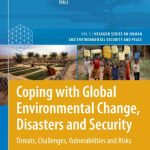BABELGUM.COM “Interview with Laureano about the desertification”
What is the cause of desertification?

There is an ongoing debate on the use of traditional knowledge and methods to safeguard and enhance the landscape, fight desertification and the waste of resources. There are opposite views on this issue everywhere. In China, for example, on the one hand, the Three Gorges dam is being built with catastrophic consequences for the regional ecosystem and every year 10 million people leave their ancient villages to move into new metropolis. On the other hand, traditional methods are largely used to protect the soil and stop desertification.
According to The United Nations Convention to Combat Desertification (UNCCD), desertification is caused by human activities and climatic variations. The impact of human activities is fundamental. This is also true as far as positive activities are concerned. By using water more efficiently and by learning that natural resources are cyclic and that therefore we need to avoid wasting resources we can combat both physical and cultural desertification.
What are the problems regarding water distribution and how can we promote sustainable management of water resources?
70% of potable water is currently used for irrigation in agriculture and manufacturing processes and the remaining is used for bathing and washing in the city. In agriculture, drainage basins that dry rivers are being built. Cities with their cement buildings prevent the rainwater from being channelled into the ground and use too much drinking water that is precious to many populations. Most people drink mineral water at home and most potable water in the house is discharged in the toilet and thrown away as wastewater. The so-called “dual system”, that is, having two kinds of water pipes in the house, should be implemented in the city. One provides potable water of a good quality threshold that can replace mineral water. The other can be used in the bathroom and in the rest of the house and comes from recycled rainwater or potable water of poor quality, therefore cheaper, provided by municipal aqueducts. The water used in the city should be used in agriculture as that water is full of fertilizers.
What can we learn from past civilizations in this respect?
The Mediterranean is characterized by the lack of big natural streams of water and by scarce and discontinuous precipitations. Its southern shores are mostly arid and its isles have almost no streams of water. It is in these arid or semi-arid areas that the great Mediterranean civilization has flourished thanks to its wise management of water resources. Villages were built with special materials that facilitated water collection and protected the population from the cold and the heat.
Terraces in agriculture, roof and hanging gardens in the city contributed to soil and water conservation. Terraces prevent soil erosion and absorb humidity through their stones. Roof gardens are ideal for rainwater collection and keep temperatures stable in buildings.
What have been the most significant experiences in your career?
I have really enjoyed my time in the Saharan oasis in Algeria. In the Gourara and Touat regions, people have been producing water where there’s none, using it efficiently and creating oasis for millennia. They represent a perfectly eco-sustainable model. In the Saharan region, thanks to EU funding, we are restoring traditional artificial gorges and water collection networks and bringing deserted oasis back to life. This project has also contributed to the restoration of similar Etruscan structures in Italy.
I have also undertaken the inscription of the Sassi of Matera on the UNESCO World Heritage List. I have lived in the gorges and used traditional water collection methods and taken advantage of the gorges’ natural cooling and heating systems.
I am also in charge of the UNESCO project on the Ipogea city of Lalibela in Ethiopia, famous for its monolithic churches, where we are restoring the original ecosystem and water collection networks.
The Traditional Knowledge World Bank provides communities and companies with traditional know-how, best practices and techniques and by doing so it promotes a new approach to technology.








